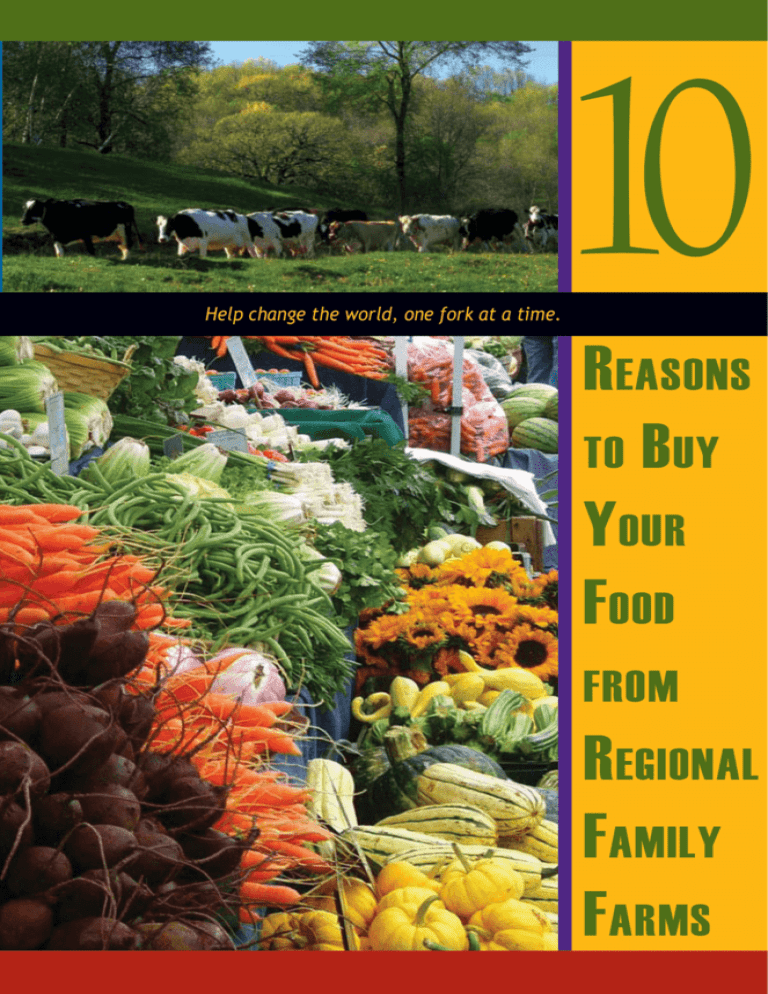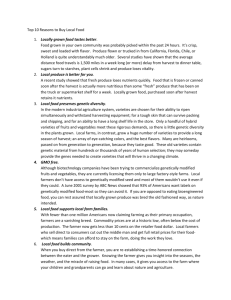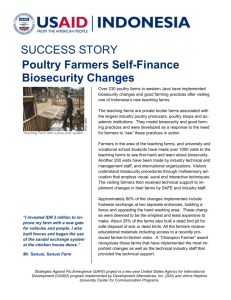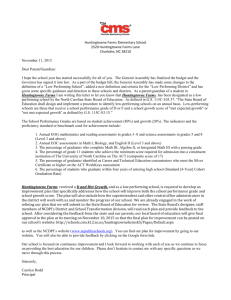Ten Reasons to Buy Your Food From Regional Family Farms
advertisement

10 Help change the world, one fork at a time. REASONS TO B UY YOUR F OOD FROM REGIONAL F AMILY F ARMS Just what is good food? More than 100,000 U.S. families lost their farms between 1996 and 2001. According to the Centers for Disease Control and Prevention, obesity-related health problems now account for nearly 10% of U.S. health care costs. Eating fresh fruit and vegetables helps reduce obesity. E veryone needs to eat. Eating good food gives us pleasure and keeps us healthy. But how do we know what is good food? Flavor is one measure. Fruits and vegetables grown for regional consumption are generally allowed to fully mature before harvest, so they taste better. In addition, studies show that foods produced organically can be nutritionally superior to those grown conventionally. Fruits and vegetables consumed shortly after harvest retain more nutrition than those stored for days or weeks before reaching grocery store shelves. J ust what do you know about the food you and your family eat? Do you know: Where it was grown? How it was grown? Who grew it? When it was harvested? When you shop in supermarkets, are you able to find out where the food was grown? Can you learn about what pesticides or fertilizers were used? Are you able to find out who the people are that grow and produce your family’s food? Do you know who’s growing your food ...and how? 60% of Farm Bill subsidies go to 10% of the largest corporate farms. D o you feel it’s important to know where your food dollar goes? If you answer “Yes!” you are concerned about where your food comes from and how it was produced. Do you know if the fruit, vegetables, dairy, meat, and other foods you buy are grown or raised nearby on family farms? Or is your family’s food grown thousands of miles away and then, using huge distribution networks, transported vast distances to local stores via ship, train, airplane, and truck? R ight now, you still have a choice. But what about tomorrow? Do today’s supermarket chains and huge agribusiness corporations foretell the demise of America’s family farms? The sponsors of this publication invite you to help us revitalize economically sustainable farming right here, close to home. It’s the best way to protect your choices for healthy, fresh foods. T ake a moment to discover ten important reasons why you should buy more of your food from nearby family farms. Buying your family’s food from nearby family farms provides you with fresher, tastier, and often much more nourishing food. It also helps make our country stronger by supporting rural communities. 1 Locally grown food is fresher and tastes better. Since 1950, riboflavin levels in grocery store produce have declined 38%. T here’s nothing like biting into a juicy, garden-ripe tomato. The juice dribbles down your chin, and the burst of intense flavor is out of this world. However, most tomatoes sold in America aren’t especially juicy or flavorful. Bred for durability not flavor, they are picked while still green and often shipped thousands of miles. To make them appear ripe when offered for sale, they are treated with ethylene gas to help them turn red quickly. How about the taste of a just-harvested peach or strawberry? If you’ve ever tasted ripe fruit picked at its peak, you know how much better it tastes. It’s impossible for fruit and vegetables that are picked, packed, stored, and shipped long distances to taste as good as those just harvested at peak maturity on regional farms. F ruit and vegetables grown for nearby consumers are harvested at the peak of ripeness for the best flavor. Family farms help protect the environment. 2 One large factory hog farm produces as much sewage as a city of 100,000 people. I n most cases, farm families live where they farm. They see themselves as stewards of the land and are more likely to use environmentally sound methods to manage pests and fertility. Large agribusiness concerns have limited ties to the land and communities where they operate. These large corporations invest in agriculture solely as a means to satisfy shareholder demands for profitability. Farmers who live where they farm often use sustainable approaches to managing pests and fertility. Considering it a precious resource, they take care of the land before passing it on to the next generation. Many of these family farms are certified for organic production, giving you an assurance of healthy food, produced without the use of synthetic pesticides, hormones, or chemical fertilizers. Remember, it was small-scale farmers that started the rapidly growing organic agriculture movement. F amily farmers are some of the most environmentally conscious land stewards. 3 Buying regionally conserves precious resources. The average grocery store item travels more than 1,500 miles to your table. B uying your food directly from farms as close to home as possible helps conserve natural resources. Corporate agribusiness conglomerates rely on a global transportation system that consumes millions of barrels of oil every year. American industrialized agriculture is amongst the least energy efficient on the planet, often consuming up to ten times more energy for production and transport than it yields. When you buy food grown closer to home, you’re helping reduce dependency on precious fossil fuels and helping put more food-buying dollars in the hands of regional farmers. Food produced for regional sale doesn’t travel far before being consumed, helping reduce carbon dioxide emissions and the need for costly packing materials. Buying local also helps to make farming more profitable and selling farmland for development less attractive. S upporting nearby farms helps preserve our planet for future generations. Thriving family farms build rural economies. 4 Today’s farmers earn less than 8¢ of every food dollar spent by consumers. D ollars generated in local communities change hands three or four times before they leave. When agribusiness corporations come to town, most dollars leave the community by close of the business day. In rural communities, economic well-being and social vitality are inextricably linked to the type of farms in the region. Family farmers buy from merchants in their own communities, helping support diverse local jobs and small businesses. A landmark study comparing two rural communities found that the family farm-dominated community had an overall higher standard of living—more retail trade and independent businesses as well as more parks, schools, churches, and community involvement than the community dominated by large, corporate agribusiness-type farms. I ncreasing the number of viable family farms helps rebuild the economic and social health of rural communities. 5 Buying local helps you learn how your food was grown. Corporate agribusiness profits have nearly doubled since 1990. B uying direct from family farms helps ensure you find safe, wholesome food for your family. When you visit local farms, farmers markets, roadside stands, and food co-ops, you gain the opportunity to talk with the farmers growing your food. Farmers supplying nearby markets are more accountable to their buyers. Since consumers can learn who these farmers are and what practices they use, they have more confidence in the safety of the foods being grown. Studies show that most consumers question the motivation of global agribusiness to produce safe, wholesome food. The studies go on to show Americans maintain great confidence in family farmers to produce wholesome food using environmentally sound methods and inputs. K nowing where your food comes from and how it was grown can help you choose healthy, nutritious food for your family. Family farms help children learn healthy values. 6 Participation in school lunch programs rises when farm-fresh food is on the menu. L ike other family-owned businesses, family farms are models for children to learn values such as cooperation and responsibility. Farm children learn to contribute by doing chores such as gathering eggs and helping with harvest. Their parents’ example helps shape their attitudes toward the land and the value of food. Many children have no idea where food comes from before it reaches the grocer’s shelves. Many have never experienced how flavorful truly ripe fruits and vegetables can be. Family farms often welcome people to visit and learn valuable lessons about food and nature. Taking children to visit a farm is a fun learning experience. Many elementary schools arrange field trips to nearby family farms to help students learn about their food. They’ve discovered that introducing children to fresh, wholesome food helps improve children’s health and educational performance. F amily farms model healthy values and provide educational opportunities. 7 Locally grown food protects genetic diversity. 95% of all commercial production dairy cows are from a single breed. D iverse family farms around the world, growing for nearby markets, raise thousands of centuries-old varieties and heritage breeds carefully selected for their flavor and ability to thrive in unique environments. Agribusiness shippers demand today’s produce items have a tough skin that can survive harvest, packing, and transport as well as have a long shelf life in the store. Only a handful of developed varieties meet these global marketing requirements, so there is little genetic diversity among the key food plants grown for mainstream markets. In contrast, diverse farms grow a broad range of produce varieties and animal breeds selected for flavor, high nutrition, and regional adaptability. Many of these varieties and breeds have been passed down for generations and contain genetic material from hundreds of years of regional selection. These broad variations may someday provide the genetic resources necessary to adapt to changing conditions. B uying locally grown products encourages robust, genetic diversity in our foods. Many family farms grow a feast for the senses. 8 In 2006, Washington’s farmers markets added $38+ million to local economies. N earby family farmers provide consumers with a broad variety of produce throughout the season. When you buy from farms closer to home, you have the opportunity to try foods that aren’t available in grocery stores. This is especially true when you buy directly through on-farm sales, farmers markets, or Community Supported Agriculture (CSA) programs. Farmers often have recipes available with great ideas for using these unique varieties. One Eastern Washington farmer grows an astonishing 82 different varieties of peppers to share with farmers market patrons on both sides of the Cascades. He grows fresh peanuts as well. You won’t find that kind of variety in any supermarket! These small farmers often grow varieties with unique flavors, colors, and shapes offering a fascinating link with history. Imagine eating the same tomato variety grown and eaten by Thomas Jefferson at Monticello! L ocal farmers provide you and your family with an ever-changing palette of rich colors, flavors, and food heritage. 9 Nearby farms help keep your taxes in check. The U.S. loses farmland at a rate of 2 acres/minute, over 240 million acres since 1970. L ocal farms contribute more in taxes than they require in services. Unfortunately, with a trend that turns existing farmland into suburban and industrial developments at a rapid clip, current attitudes towards farmland preservation ensure our taxes will rise even faster in the near future. According to several studies, for every $1 in revenue raised by residential development, governments must spend at least $1.17 on services, thus requiring higher taxes of all taxpayers. However, for each $1 in revenue raised by farms, forest, and open space, governments only spend about 34¢ on services, a net gain to the government of 66¢ on every dollar collected. W hen you support nearby farms with your food-buying dollars, you help keep government spending on services lower. Diverse family farms means food security. 10 Four agribusiness corporations control 80% of U.S. beef and pork production. S upporting family farms helps protect our ability to feed ourselves. Without thousands of thriving farms around the region, we lose the land security needed to ensure each foodshed maintains the ability to feed itself. Food from far-off places is now the norm. International food trade has tripled since 1961, and corporate agribusiness profits have nearly doubled since 1990. Apples sold in U.S. stores may come from China, while potatoes sold in Peru may have been grown in Idaho, even though the potato is native to the Andes region of South America. However, we need to think about what happens if something disrupts that constant flow of food products across continents and oceans. We must act now to guarantee the survival of diverse family farms. If we don’t, the inevitable disruption of global agribusiness networks will become a serious hardship to our families and communities. S upporting regional family farms helps ensure we can feed ourselves not just now, but well into the future. Here’s what you can do to support family farms. Washington State farmers grow and produce more than 300 different foods and crops. 3 3 3 3 3 3 3 3 3 Buy your food directly from regional farms and stock up on your family’s favorites. Visit your local farmers market regularly during the season. Join a CSA and receive weekly boxes of fresh, local produce. Ask your grocery store manager to stock locally grown farm products. Serve your family and friends meals prepared with fresh, local ingredients. Encourage school districts and hospitals to buy and serve locally grown foods. Feature local fresh foods at your organization’s next meeting or event. Demand Country of Origin Labeling on all the foods you buy. Tell elected officials to support regionally based agriculture to help keep our farm families living and working on the land. 60% of all U.S. retail food sales goes through just five supermarket chains. V isit these organizations’ web sites for more information on what you can do to help support family farms growing healthy food. Tilth Producers of Washington www.tilthproducers.org Initiative for Rural Innovation & Stewardship/North Central Washington Resource Conservation & Development District: www.ncwrcd.org Puget Sound Fresh www.pugetsoundfresh.org Washington Sustainable Food & Farming Network www.wsffn.org Washington State Farmers Market Association www.wafarmersmarkets.com 21 Acres www.21acres.org Sustainable Northwest www.sustainablenorthwest.org WSU Center for Sustainable Agriculture & Natural Resources www.csanr.wsu.edu Local Harvest www.localharvest.org Sustainable Connections www.sconnect.org Skagitonians to Preserve Farmland www.skagitonians.org Education & Agriculture Together www.eatncw.org Cascade Harvest Coalition www.cascadeharvest.org Cascade Foothills Farmland Association www.visitwashingtonfarms.com WSU Small Farm Team smallfarms.wsu.edu Farm to School www.farmtoschool.org Action for Healthy Kids www.actionforhealthykids.org Heifer International www.heifer.org PCC Farmland Trust www.pccnaturalmarkets.com/ farmtrust/ Northwest Agriculture Business Center www.AgBizCenter.org Help conserve resources and pass this booklet along after you are done reading it. Think globally. Eat locally! Original concept by the Institute for Rural Innovation & Stewardship and Tilth Producers of Washington. Produced through the generosity of WSU Small Farm Team, Cascade Foothills Farmland Association, Cascade Harvest Coalition, HumanLinks Foundation, PCC Natural Markets, Heifer International, Northwest Agriculture Business Center, Sustainable Connections, Tilth Producers, the Institute for Rural Innovation & Stewardship, & the Community Foundation of North Central Washington. Text by: Chris Rader, Kent Mullinix, & Kate Halstead Design & layout: Kate Halstead Photo credits: Front cover bottom: © 2006 Tilth Producers of Washington Front cover top, pages 7, 13, 15 lower, back page upper left: © 2006 Organic Valley Family of Farms Page 3: © 2006 Carrie Branovan for Organic Valley Family of Farms Pages 2, 9, 10, 14 top, 15 top, back cover top right & bottom: courtesy USDA Agriculture Research Service Page 12: © 2006 Puget Consumer Co-op All others: © 2008 Kate Halstead








